Ever faced an error in your Java program that wasn’t covered by the standard exceptions and wondered how to handle it? Maybe something very specific to your app?
That’s where the custom exceptions in Java come in.
Creating custom exceptions allows you to handle unique situations in your code. You can make your errors clearer and more meaningful.
This blog will guide you through creating a custom exception in Java. We’ll cover the steps and differences between checked and unchecked exceptions and provide practical examples.
Why Custom Exceptions Are Essential in Java Programming
Imagine you’re building a banking app and need to check for a specific error that the standard exceptions don’t cover: A user tries to withdraw more money than they have.
A standard exception might not provide the best feedback. But, a custom exception can give a clear, understandable error message.
A custom exception can:
- Handle errors specific to your application.
- Make your code easier to understand.
- Provide clear messages to users and developers.
- Handle business rules and workflows.
Also Read: Types of Exceptions in Java

POSTGRADUATE PROGRAM IN
Multi Cloud Architecture & DevOps
Master cloud architecture, DevOps practices, and automation to build scalable, resilient systems.
Steps to Create a Custom Exception in Java
Creating a custom exception in Java is straightforward. Here’s a step-by-step guide:
Define a New Class that Extends the Exception Class
First, create a new class that extends the Exception class.
class MyCustomException extends Exception {
public MyCustomException(String message) {
super(message);
}
}
This class is now your custom exception.
Using the super() Method
Use the super() method to pass a message to the parent class.
public MyCustomException(String message) {
super(message);
}
This lets you set a custom error message when the exception is thrown.
Overriding the toString() Method
Override the toString() method to customise the error message.
@Override
public String toString() {
return "MyCustomException: " + getMessage();
}
This makes your exception message more readable.
Detailed Explanation of Checked vs. Unchecked Exceptions
Java exceptions fall into two categories: checked and unchecked. Understanding the difference is crucial.
Checked Exceptions
- Extend the Exception class.
- Must be caught or declared in the method signature.
- Must handle these exceptions in your code.
class FileNotFoundException extends Exception {
public FileNotFoundException(String message) {
super(message);
}
}
Unchecked Exceptions
- Extend the RuntimeException class.
- Do not need to be caught or declared.
- They can be ignored, but it’s better to handle them.
class IllegalArgumentException extends RuntimeException {
public IllegalArgumentException(String message) {
super(message);
}
}
Practical Examples of Implementing Custom Exceptions
Example 1: Handling Invalid User Input with Custom Exceptions
Imagine you’re developing an app and need to validate user input. What if the input is empty or null? A custom exception can make this clear and simple.
class InvalidUserInputException extends Exception {
public InvalidUserInputException(String message) {
super(message);
}
}
public class UserInputHandler {
public void validateInput(String input) throws InvalidUserInputException {
if (input == null || input.isEmpty()) {
throw new InvalidUserInputException("Input cannot be null or empty");
}
}
public static void main(String[] args) {
UserInputHandler handler = new UserInputHandler();
try {
handler.validateInput("");
} catch (InvalidUserInputException e) {
System.out.println(e.getMessage());
}
}
}
Output:
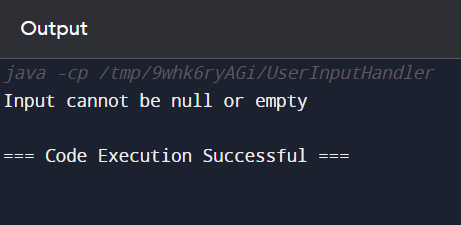
In this example, InvalidUserInputException is thrown when the input is invalid. It makes the code easy to read and understand.
Example 2: Creating a Custom Exception for File Operations
Handling file operations can get tricky. What if a file doesn’t exist? A custom exception can help here, too.
import java.io.File;
class FileProcessingException extends Exception {
public FileProcessingException(String message) {
super(message);
}
}
class FileHandler {
public void readFile(String filePath) throws FileProcessingException {
if (!new File(filePath).exists()) {
throw new FileProcessingException("File not found: " + filePath);
}
// File processing logic
}
}
public class Main {
public static void main(String[] args) {
FileHandler handler = new FileHandler();
try {
handler.readFile("nonexistent.txt");
} catch (FileProcessingException e) {
System.out.println(e.getMessage());
}
}
}
Output:
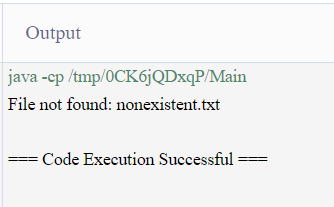
Here, FileProcessingException makes it clear that the issue is with the file. It tells the user exactly what went wrong.
Example 3: Using Custom Exceptions for Business Logic
Business logic can be complex. For instance, what if there are not enough funds for a transaction? A custom exception makes this specific and understandable.
class InsufficientFundsException extends Exception {
private double amount;
public InsufficientFundsException(double amount) {
super("Insufficient funds for transaction. Required: " + amount);
this.amount = amount;
}
public double getAmount() {
return amount;
}
}
public class BankAccount {
private double balance;
public BankAccount(double balance) {
this.balance = balance;
}
public void withdraw(double amount) throws InsufficientFundsException {
if (amount > balance) {
throw new InsufficientFundsException(amount);
}
balance -= amount;
}
public static void main(String[] args) {
BankAccount account = new BankAccount(100);
try {
account.withdraw(150);
} catch (InsufficientFundsException e) {
System.out.println(e.getMessage());
}
}
}
Output:
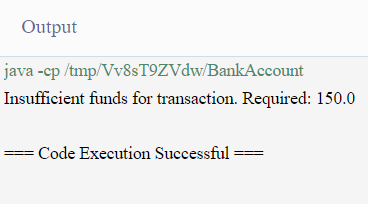
With InsufficientFundsException, the error message directly tells the user why the transaction failed.
Example 4: Custom Exception for Database Operations
Connecting to a database can also throw specific errors. A custom exception can handle these neatly.
class DatabaseConnectionException extends Exception {
public DatabaseConnectionException(String message) {
super(message);
}
}
public class DatabaseHandler {
public void connect(String connectionString) throws DatabaseConnectionException {
if (connectionString == null || connectionString.isEmpty()) {
throw new DatabaseConnectionException("Database connection string cannot be null or empty");
}
// Database connection logic
}
public static void main(String[] args) {
DatabaseHandler handler = new DatabaseHandler();
try {
handler.connect("");
} catch (DatabaseConnectionException e) {
System.out.println(e.getMessage());
}
}
}
Output:
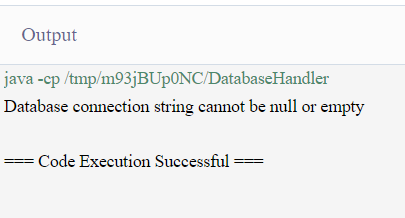
This example shows DatabaseConnectionException to handle connection issues specifically.
Example 5: Network Communication Custom Exception
Network operations often face errors. A custom exception makes error handling more straightforward.
class NetworkCommunicationException extends Exception {
public NetworkCommunicationException(String message) {
super(message);
}
}
public class NetworkHandler {
public void sendRequest(String url) throws NetworkCommunicationException {
if (url == null || url.isEmpty()) {
throw new NetworkCommunicationException("URL cannot be null or empty");
}
// Network communication logic
}
public static void main(String[] args) {
NetworkHandler handler = new NetworkHandler();
try {
handler.sendRequest("");
} catch (NetworkCommunicationException e) {
System.out.println(e.getMessage());
}
}
}
Output:
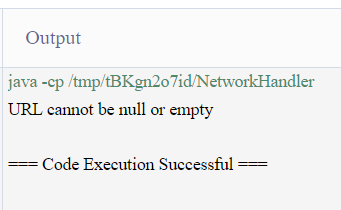
Using NetworkCommunicationException, the code makes it clear when a URL is invalid.

82.9%
of professionals don't believe their degree can help them get ahead at work.
Best Practices for Defining Custom Exception in Java
Creating custom exceptions is useful, but there are best practices to follow.
- Use clear, meaningful names for your exceptions.
- Provide detailed error messages.
- Include extra fields if necessary to convey more information.
- Don’t create custom exceptions for situations already covered by standard exceptions.
- Clearly document the purpose of each custom exception.
Conclusion
The custom exception in Java is the tool for handling particular error conditions. They make your code cleaner, clearer, and easier to maintain.
In this article, we have gone through the power of custom exceptions in Java. We have learnt how to handle certain error conditions by creating our own exceptions. We have covered practical examples that range from user input to file operations, business logic, database connections, and networking.
Custom exceptions in Java make your code more readable, maintainable, and precise. Following the best practices, you will efficiently deal with failures and increase the overall effectiveness of your applications.
What is the difference between Checked and Unchecked Exceptions?
- Checked exceptions must either be declared or caught, whereas unchecked is not required to be handled explicitly.
When should I use custom exceptions?
- Use them for specific error conditions not covered by standard exceptions, especially for business logic.
Can I create custom runtime exceptions?
- Yes, extend the RuntimeException class.
How do I pass a custom message to a custom exception?
- Use a constructor in your exception class that calls the superclass constructor with the message.
Is it a good practice to use custom exceptions for all error conditions?
- No, use them selectively for specific scenarios. Standard exceptions should cover common errors.
Updated on January 20, 2025
